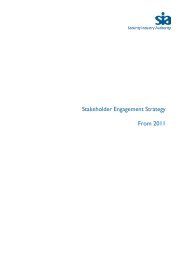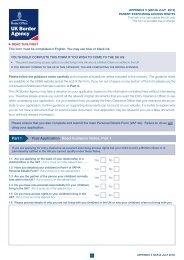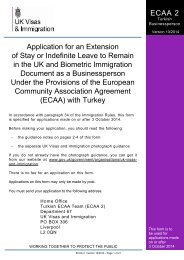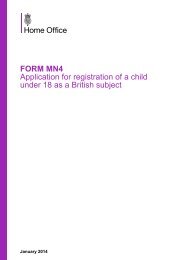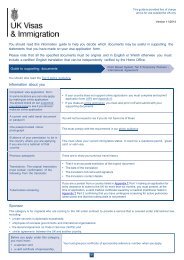ACS Assessor Guide - Security Industry Authority
ACS Assessor Guide - Security Industry Authority
ACS Assessor Guide - Security Industry Authority
Create successful ePaper yourself
Turn your PDF publications into a flip-book with our unique Google optimized e-Paper software.
<strong>ACS</strong> <strong>Assessor</strong> <strong>Guide</strong>Section 3 – Overall ConsiderationsOngoing ImprovementIn addition to the size of the applicant organisation, the length of time trading willalso have an impact on the type of evidence provided. Newer applicantorganisations will have less developed approaches, not yet reviewed withimprovements identified and implemented. It is important however to ensure thatthese applicant organisations can demonstrate that they have considered anddeveloped approaches to handle an improvement cycle. Mature applicantorganisations should be able to demonstrate better developed approaches andmethods as a result of multiple improvement cycles.3.2. Current StandardsThe <strong>ACS</strong> Self Assessment Workbook <strong>Guide</strong> has been cross referenced withISO9001and the relevant British Standards to assist both the applicant and theassessor to identify where they are appropriate.Smaller applicant organisations and those applicant organisations that are relativelynew to the security industry are less likely to have certification to ISO9001thanlarger and more mature applicant organisations. The exception to this would bethe Cash and Valuables in Transit sector where, due to the nature of the business,all applicant organisations may need to be accredited and compliant to meetcustomer requirements.Where an applicant organisation is UKAS ISO900 registered and/or candemonstrate, through other certification that they are compliant to the relevantBritish Standards then the sampling levels may be reduced. However, the assessorshould review recent audit reports and undertake some limited checks to giveconfidence that this approach is safe.Approved contractors are expected to work to the British Standard Codes ofPractice relevant to their sector(s). Since these are codes of practice and notrequirements standards assessors must be flexible in their interpretation of howconformance to the codes is demonstrated. It is anticipated that some detail inthe codes of practice will not be appropriate to every contractor. Any deviationfrom the recommendations in an applicable code of practice should be justified bythe contractor. In such cases, if the assessor and the contractor are not in fullagreement then the SIA will arbitrate. If a contractor holds a certificate ofconformance to the relevant codes of practice then only the requirementsspecified in the SAW should be assessed.Figure 2 – Existing <strong>Security</strong> <strong>Industry</strong> Codes of Practice identifies therelevant codes of practice for each activity for which <strong>ACS</strong> approval is available.Contractors seeking approval for a particular activity should work to the code(s)of practice listed.3.3. ApproachesAs discussed in Section 3.1 – Organisation, the approaches used will varydepending on the size and maturity of the applicant organisation. It is importantthat the assessor, whatever the approach, is satisfied that they are appropriateand contribute to the desired outcome. In order to deliver the desired outcomeapproaches have to be fully implemented. It is here that the assessor must plan totalk to as many employees, customers and possibly consumers as is necessary, inorder to test.It is feasible that assessors will be requested to conduct a combinedassessment/audit against the <strong>ACS</strong> Standard, ISO9001and/or the relevant BritishStandard. This is acceptable provided that all aspects are covered in theassessment and the integrity of any of the standards is not compromised.12The contents of this publication are copyright ©2013 <strong>Security</strong> <strong>Industry</strong> <strong>Authority</strong>, all rights reserved. No part of the contents may be reproduced or transmitted in any form, by any means without prior written permission of the copyright owner.




